Strategic Analysis of Tesco and Aldi
VerifiedAdded on 2020/02/05
|16
|3663
|72
Essay
AI Summary
This assignment delves into a comparative strategic analysis of two major supermarket chains, Tesco and Aldi. It examines their respective market positions, competitive strategies, and potential challenges. The analysis utilizes various frameworks, including the Ansoff Matrix and Bowman's Strategy Clock, to evaluate each company's strengths, weaknesses, opportunities, and threats (SWOT). Furthermore, it considers external factors influencing the retail industry, such as changing consumer trends and technological advancements.
Contribute Materials
Your contribution can guide someone’s learning journey. Share your
documents today.
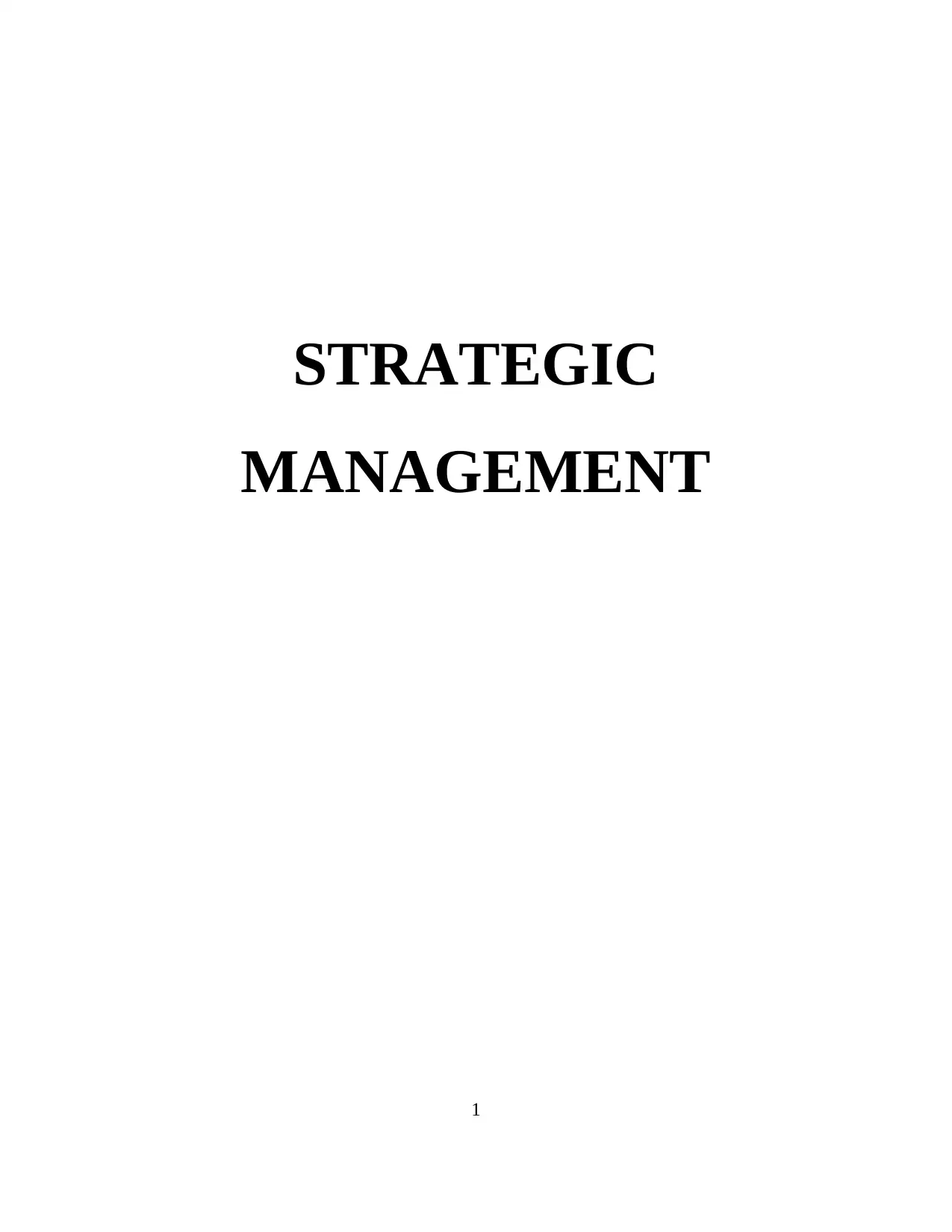
STRATEGIC
MANAGEMENT
1
MANAGEMENT
1
Secure Best Marks with AI Grader
Need help grading? Try our AI Grader for instant feedback on your assignments.
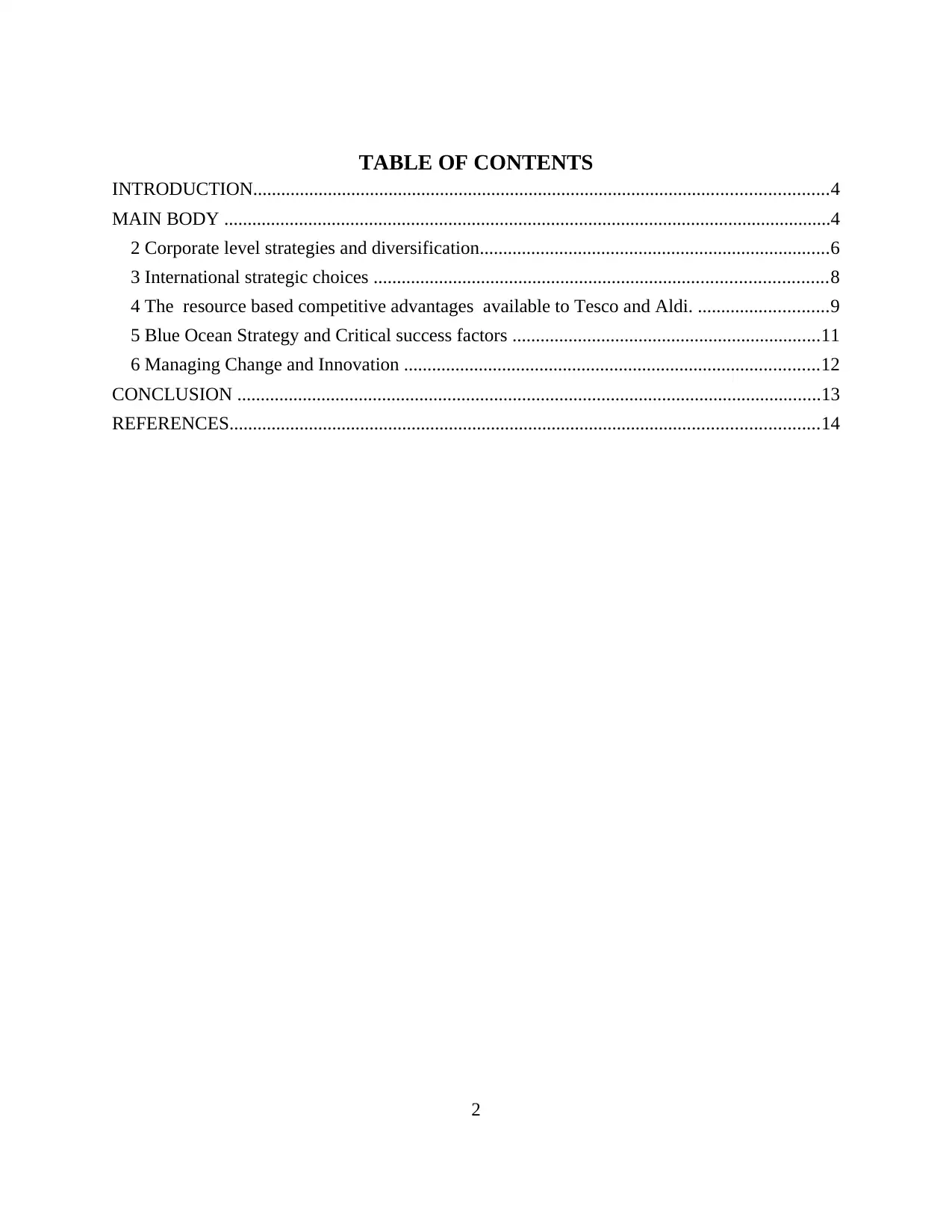
TABLE OF CONTENTS
INTRODUCTION...........................................................................................................................4
MAIN BODY ..................................................................................................................................4
2 Corporate level strategies and diversification...........................................................................6
3 International strategic choices .................................................................................................8
4 The resource based competitive advantages available to Tesco and Aldi. ............................9
5 Blue Ocean Strategy and Critical success factors ..................................................................11
6 Managing Change and Innovation .........................................................................................12
CONCLUSION .............................................................................................................................13
REFERENCES..............................................................................................................................14
2
INTRODUCTION...........................................................................................................................4
MAIN BODY ..................................................................................................................................4
2 Corporate level strategies and diversification...........................................................................6
3 International strategic choices .................................................................................................8
4 The resource based competitive advantages available to Tesco and Aldi. ............................9
5 Blue Ocean Strategy and Critical success factors ..................................................................11
6 Managing Change and Innovation .........................................................................................12
CONCLUSION .............................................................................................................................13
REFERENCES..............................................................................................................................14
2
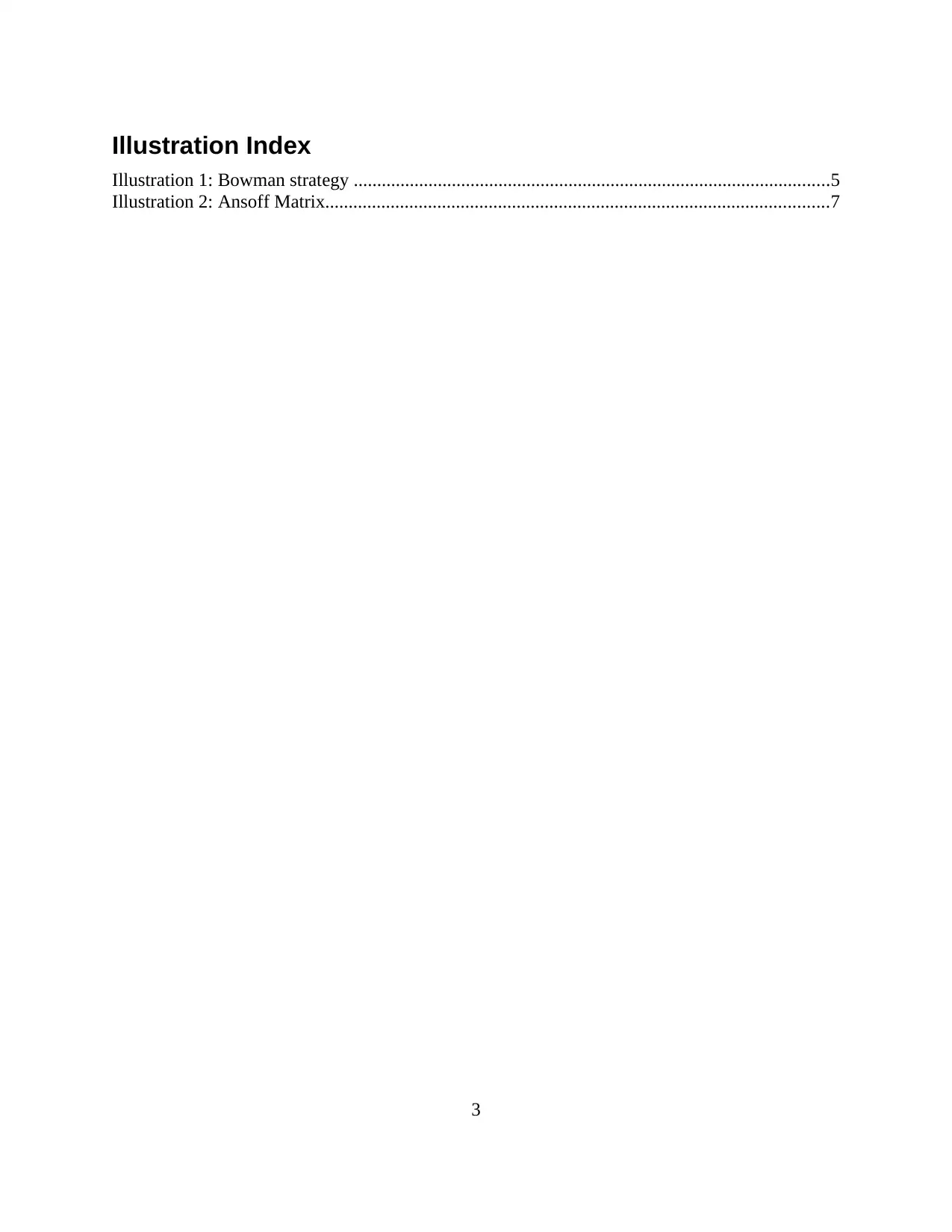
Illustration Index
Illustration 1: Bowman strategy ......................................................................................................5
Illustration 2: Ansoff Matrix............................................................................................................7
3
Illustration 1: Bowman strategy ......................................................................................................5
Illustration 2: Ansoff Matrix............................................................................................................7
3
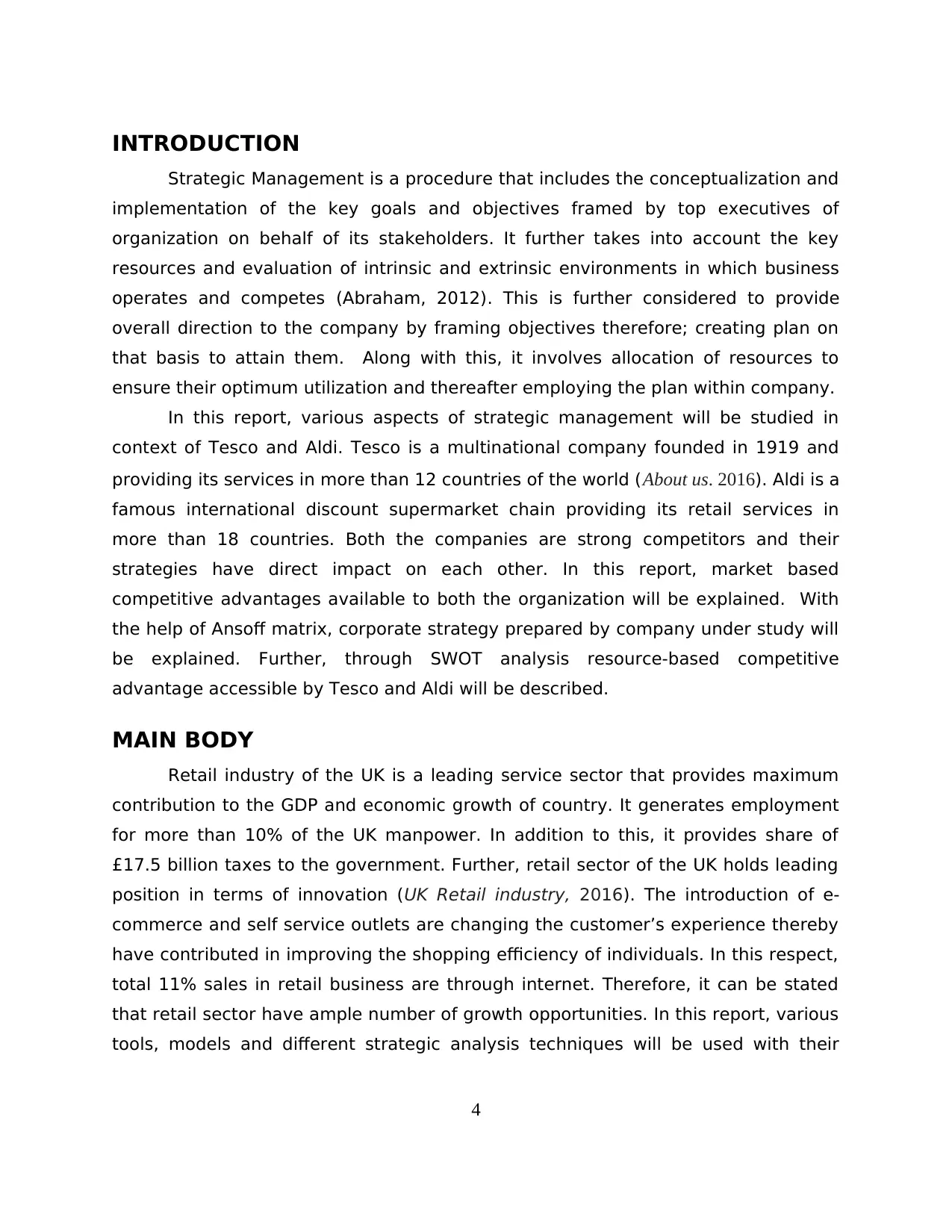
INTRODUCTION
Strategic Management is a procedure that includes the conceptualization and
implementation of the key goals and objectives framed by top executives of
organization on behalf of its stakeholders. It further takes into account the key
resources and evaluation of intrinsic and extrinsic environments in which business
operates and competes (Abraham, 2012). This is further considered to provide
overall direction to the company by framing objectives therefore; creating plan on
that basis to attain them. Along with this, it involves allocation of resources to
ensure their optimum utilization and thereafter employing the plan within company.
In this report, various aspects of strategic management will be studied in
context of Tesco and Aldi. Tesco is a multinational company founded in 1919 and
providing its services in more than 12 countries of the world (About us. 2016). Aldi is a
famous international discount supermarket chain providing its retail services in
more than 18 countries. Both the companies are strong competitors and their
strategies have direct impact on each other. In this report, market based
competitive advantages available to both the organization will be explained. With
the help of Ansoff matrix, corporate strategy prepared by company under study will
be explained. Further, through SWOT analysis resource-based competitive
advantage accessible by Tesco and Aldi will be described.
MAIN BODY
Retail industry of the UK is a leading service sector that provides maximum
contribution to the GDP and economic growth of country. It generates employment
for more than 10% of the UK manpower. In addition to this, it provides share of
£17.5 billion taxes to the government. Further, retail sector of the UK holds leading
position in terms of innovation (UK Retail industry, 2016). The introduction of e-
commerce and self service outlets are changing the customer’s experience thereby
have contributed in improving the shopping efficiency of individuals. In this respect,
total 11% sales in retail business are through internet. Therefore, it can be stated
that retail sector have ample number of growth opportunities. In this report, various
tools, models and different strategic analysis techniques will be used with their
4
Strategic Management is a procedure that includes the conceptualization and
implementation of the key goals and objectives framed by top executives of
organization on behalf of its stakeholders. It further takes into account the key
resources and evaluation of intrinsic and extrinsic environments in which business
operates and competes (Abraham, 2012). This is further considered to provide
overall direction to the company by framing objectives therefore; creating plan on
that basis to attain them. Along with this, it involves allocation of resources to
ensure their optimum utilization and thereafter employing the plan within company.
In this report, various aspects of strategic management will be studied in
context of Tesco and Aldi. Tesco is a multinational company founded in 1919 and
providing its services in more than 12 countries of the world (About us. 2016). Aldi is a
famous international discount supermarket chain providing its retail services in
more than 18 countries. Both the companies are strong competitors and their
strategies have direct impact on each other. In this report, market based
competitive advantages available to both the organization will be explained. With
the help of Ansoff matrix, corporate strategy prepared by company under study will
be explained. Further, through SWOT analysis resource-based competitive
advantage accessible by Tesco and Aldi will be described.
MAIN BODY
Retail industry of the UK is a leading service sector that provides maximum
contribution to the GDP and economic growth of country. It generates employment
for more than 10% of the UK manpower. In addition to this, it provides share of
£17.5 billion taxes to the government. Further, retail sector of the UK holds leading
position in terms of innovation (UK Retail industry, 2016). The introduction of e-
commerce and self service outlets are changing the customer’s experience thereby
have contributed in improving the shopping efficiency of individuals. In this respect,
total 11% sales in retail business are through internet. Therefore, it can be stated
that retail sector have ample number of growth opportunities. In this report, various
tools, models and different strategic analysis techniques will be used with their
4
Paraphrase This Document
Need a fresh take? Get an instant paraphrase of this document with our AI Paraphraser
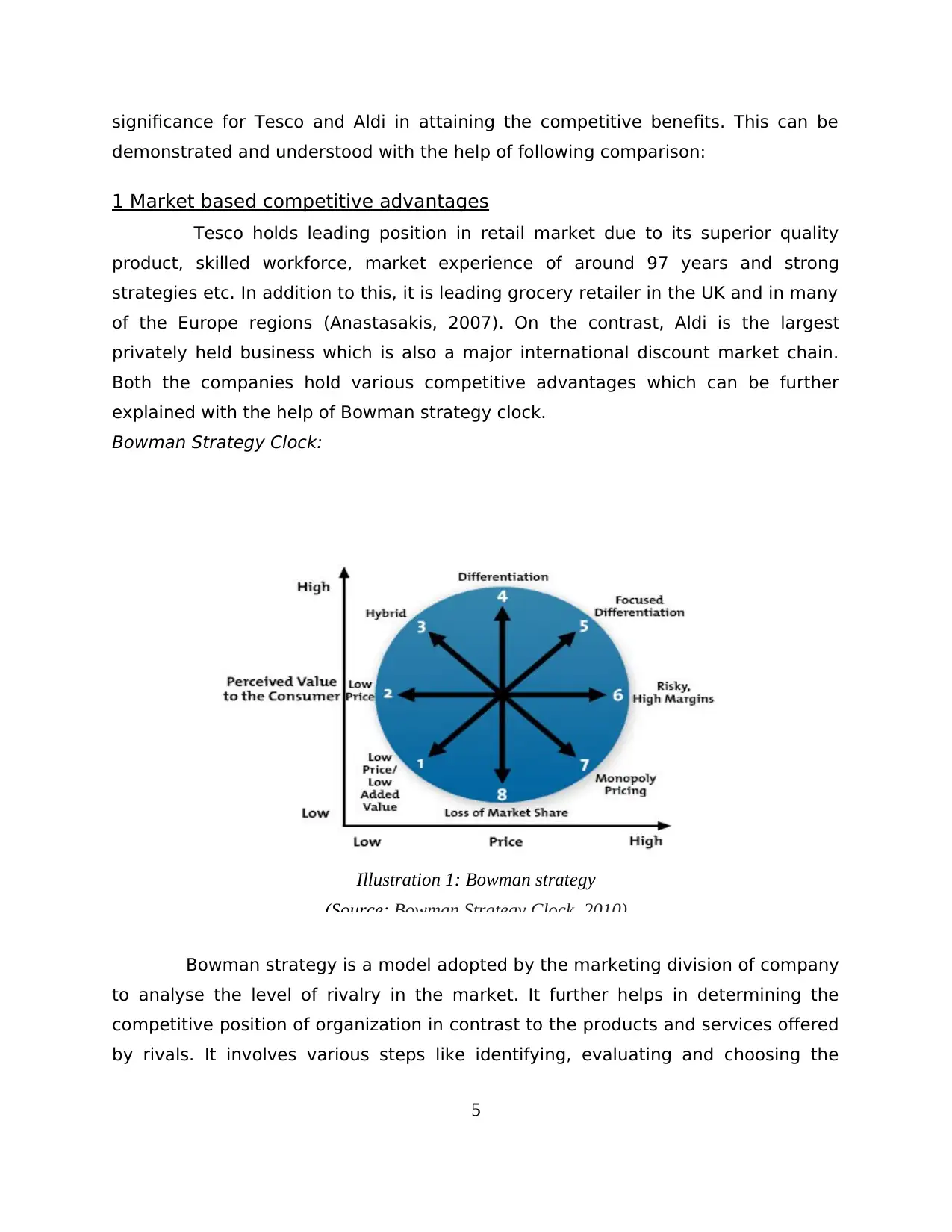
significance for Tesco and Aldi in attaining the competitive benefits. This can be
demonstrated and understood with the help of following comparison:
1 Market based competitive advantages
Tesco holds leading position in retail market due to its superior quality
product, skilled workforce, market experience of around 97 years and strong
strategies etc. In addition to this, it is leading grocery retailer in the UK and in many
of the Europe regions (Anastasakis, 2007). On the contrast, Aldi is the largest
privately held business which is also a major international discount market chain.
Both the companies hold various competitive advantages which can be further
explained with the help of Bowman strategy clock.
Bowman Strategy Clock:
Bowman strategy is a model adopted by the marketing division of company
to analyse the level of rivalry in the market. It further helps in determining the
competitive position of organization in contrast to the products and services offered
by rivals. It involves various steps like identifying, evaluating and choosing the
5
Illustration 1: Bowman strategy
(Source: Bowman Strategy Clock. 2010)
demonstrated and understood with the help of following comparison:
1 Market based competitive advantages
Tesco holds leading position in retail market due to its superior quality
product, skilled workforce, market experience of around 97 years and strong
strategies etc. In addition to this, it is leading grocery retailer in the UK and in many
of the Europe regions (Anastasakis, 2007). On the contrast, Aldi is the largest
privately held business which is also a major international discount market chain.
Both the companies hold various competitive advantages which can be further
explained with the help of Bowman strategy clock.
Bowman Strategy Clock:
Bowman strategy is a model adopted by the marketing division of company
to analyse the level of rivalry in the market. It further helps in determining the
competitive position of organization in contrast to the products and services offered
by rivals. It involves various steps like identifying, evaluating and choosing the
5
Illustration 1: Bowman strategy
(Source: Bowman Strategy Clock. 2010)
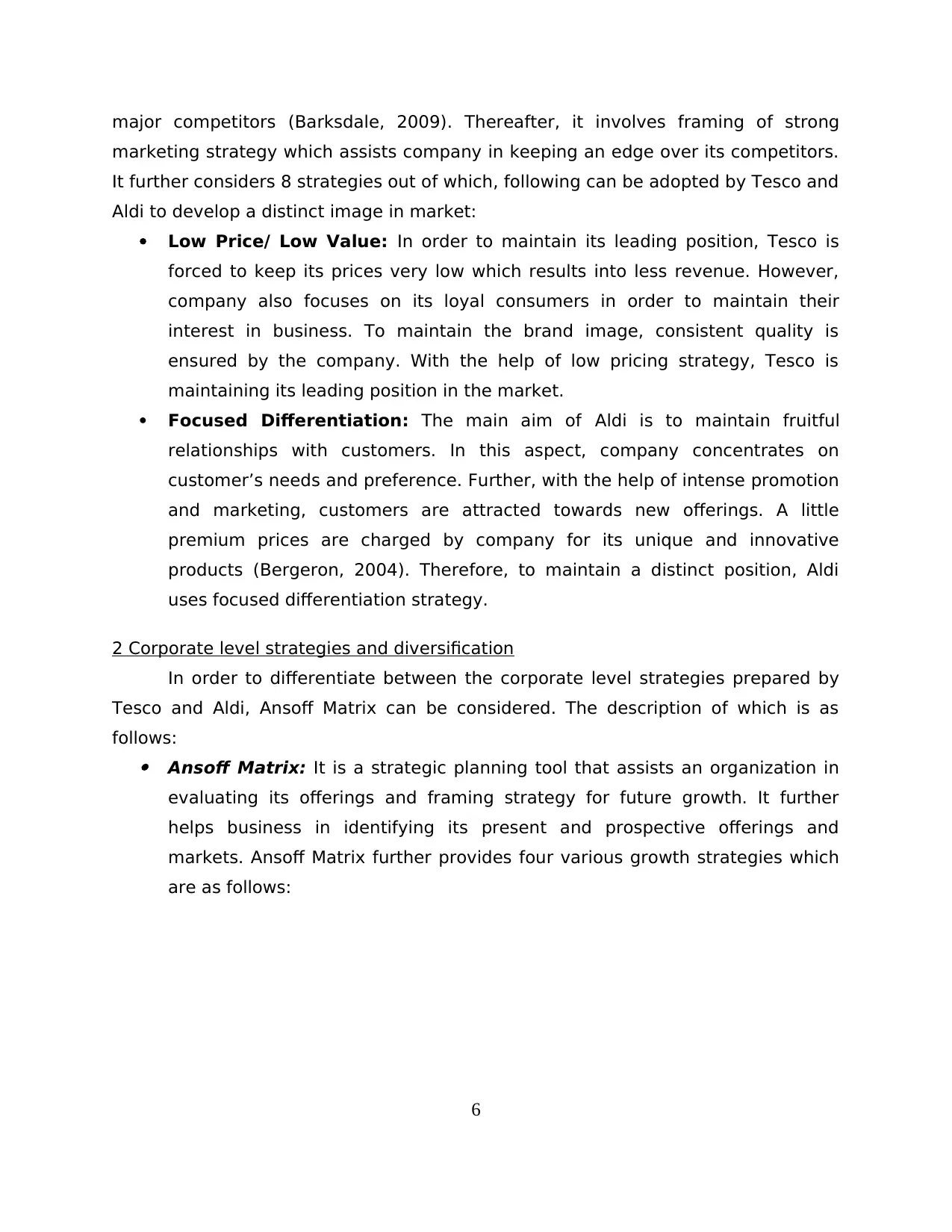
major competitors (Barksdale, 2009). Thereafter, it involves framing of strong
marketing strategy which assists company in keeping an edge over its competitors.
It further considers 8 strategies out of which, following can be adopted by Tesco and
Aldi to develop a distinct image in market:
Low Price/ Low Value: In order to maintain its leading position, Tesco is
forced to keep its prices very low which results into less revenue. However,
company also focuses on its loyal consumers in order to maintain their
interest in business. To maintain the brand image, consistent quality is
ensured by the company. With the help of low pricing strategy, Tesco is
maintaining its leading position in the market.
Focused Differentiation: The main aim of Aldi is to maintain fruitful
relationships with customers. In this aspect, company concentrates on
customer’s needs and preference. Further, with the help of intense promotion
and marketing, customers are attracted towards new offerings. A little
premium prices are charged by company for its unique and innovative
products (Bergeron, 2004). Therefore, to maintain a distinct position, Aldi
uses focused differentiation strategy.
2 Corporate level strategies and diversification
In order to differentiate between the corporate level strategies prepared by
Tesco and Aldi, Ansoff Matrix can be considered. The description of which is as
follows: Ansoff Matrix: It is a strategic planning tool that assists an organization in
evaluating its offerings and framing strategy for future growth. It further
helps business in identifying its present and prospective offerings and
markets. Ansoff Matrix further provides four various growth strategies which
are as follows:
6
marketing strategy which assists company in keeping an edge over its competitors.
It further considers 8 strategies out of which, following can be adopted by Tesco and
Aldi to develop a distinct image in market:
Low Price/ Low Value: In order to maintain its leading position, Tesco is
forced to keep its prices very low which results into less revenue. However,
company also focuses on its loyal consumers in order to maintain their
interest in business. To maintain the brand image, consistent quality is
ensured by the company. With the help of low pricing strategy, Tesco is
maintaining its leading position in the market.
Focused Differentiation: The main aim of Aldi is to maintain fruitful
relationships with customers. In this aspect, company concentrates on
customer’s needs and preference. Further, with the help of intense promotion
and marketing, customers are attracted towards new offerings. A little
premium prices are charged by company for its unique and innovative
products (Bergeron, 2004). Therefore, to maintain a distinct position, Aldi
uses focused differentiation strategy.
2 Corporate level strategies and diversification
In order to differentiate between the corporate level strategies prepared by
Tesco and Aldi, Ansoff Matrix can be considered. The description of which is as
follows: Ansoff Matrix: It is a strategic planning tool that assists an organization in
evaluating its offerings and framing strategy for future growth. It further
helps business in identifying its present and prospective offerings and
markets. Ansoff Matrix further provides four various growth strategies which
are as follows:
6
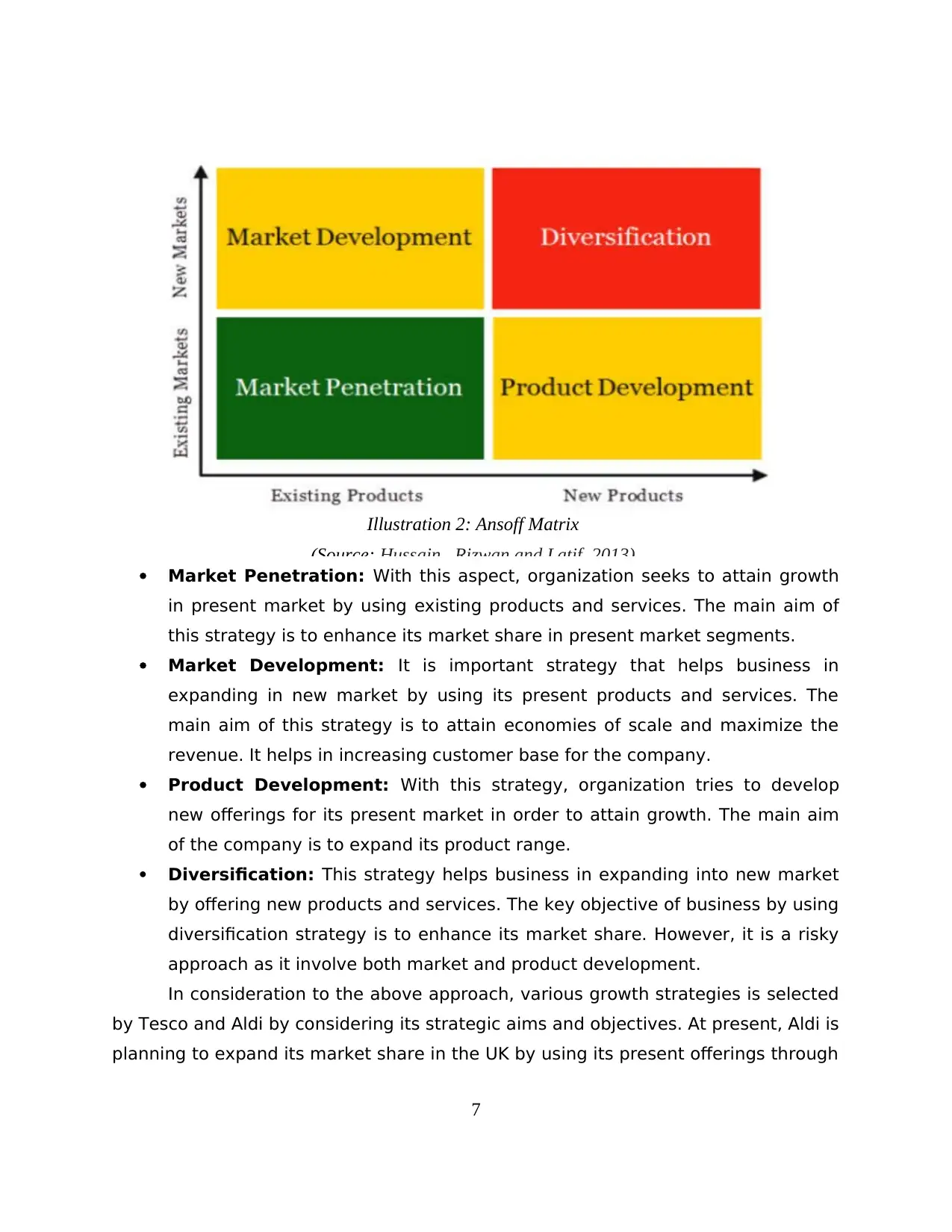
Market Penetration: With this aspect, organization seeks to attain growth
in present market by using existing products and services. The main aim of
this strategy is to enhance its market share in present market segments.
Market Development: It is important strategy that helps business in
expanding in new market by using its present products and services. The
main aim of this strategy is to attain economies of scale and maximize the
revenue. It helps in increasing customer base for the company.
Product Development: With this strategy, organization tries to develop
new offerings for its present market in order to attain growth. The main aim
of the company is to expand its product range.
Diversification: This strategy helps business in expanding into new market
by offering new products and services. The key objective of business by using
diversification strategy is to enhance its market share. However, it is a risky
approach as it involve both market and product development.
In consideration to the above approach, various growth strategies is selected
by Tesco and Aldi by considering its strategic aims and objectives. At present, Aldi is
planning to expand its market share in the UK by using its present offerings through
7
Illustration 2: Ansoff Matrix
(Source: Hussain, Rizwan and Latif, 2013)
in present market by using existing products and services. The main aim of
this strategy is to enhance its market share in present market segments.
Market Development: It is important strategy that helps business in
expanding in new market by using its present products and services. The
main aim of this strategy is to attain economies of scale and maximize the
revenue. It helps in increasing customer base for the company.
Product Development: With this strategy, organization tries to develop
new offerings for its present market in order to attain growth. The main aim
of the company is to expand its product range.
Diversification: This strategy helps business in expanding into new market
by offering new products and services. The key objective of business by using
diversification strategy is to enhance its market share. However, it is a risky
approach as it involve both market and product development.
In consideration to the above approach, various growth strategies is selected
by Tesco and Aldi by considering its strategic aims and objectives. At present, Aldi is
planning to expand its market share in the UK by using its present offerings through
7
Illustration 2: Ansoff Matrix
(Source: Hussain, Rizwan and Latif, 2013)
Secure Best Marks with AI Grader
Need help grading? Try our AI Grader for instant feedback on your assignments.
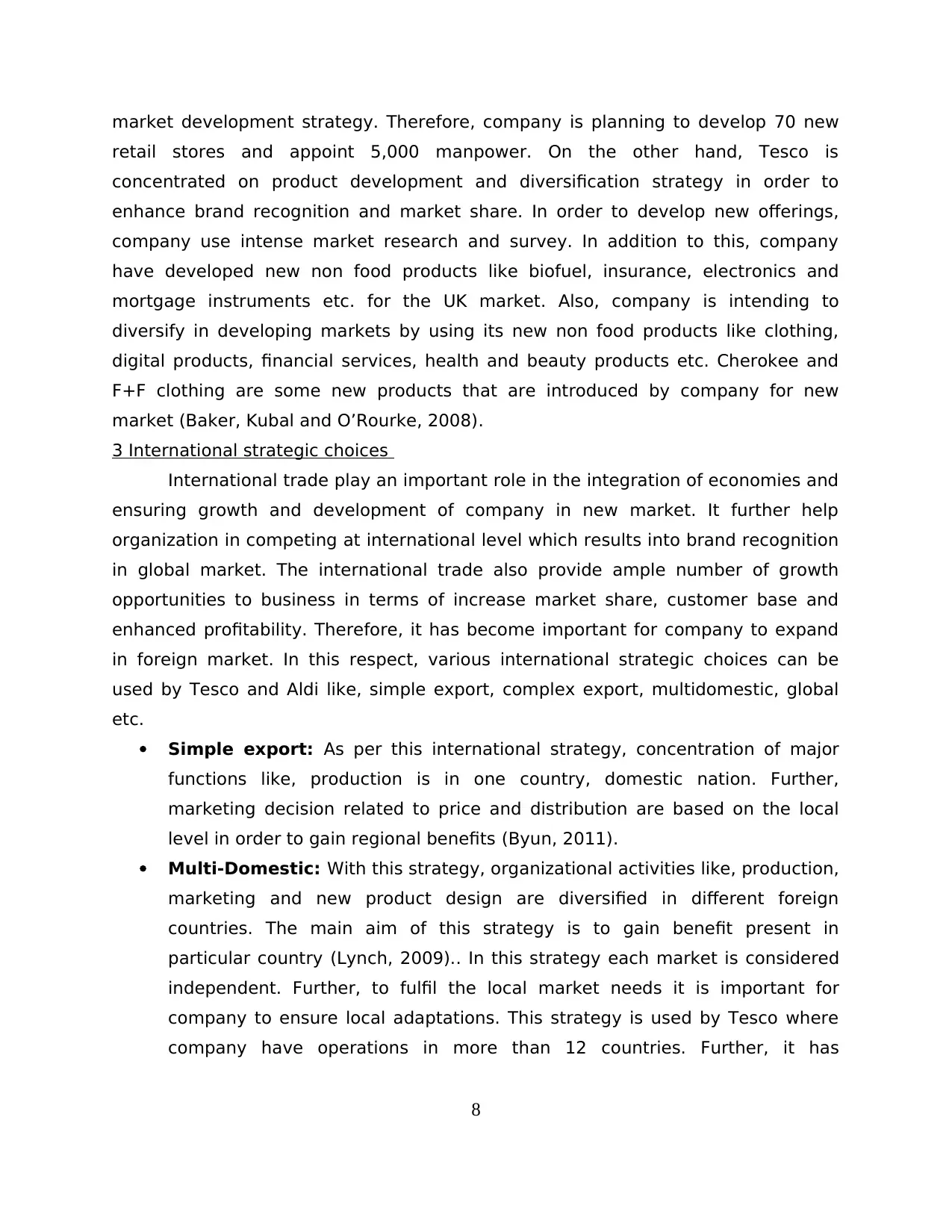
market development strategy. Therefore, company is planning to develop 70 new
retail stores and appoint 5,000 manpower. On the other hand, Tesco is
concentrated on product development and diversification strategy in order to
enhance brand recognition and market share. In order to develop new offerings,
company use intense market research and survey. In addition to this, company
have developed new non food products like biofuel, insurance, electronics and
mortgage instruments etc. for the UK market. Also, company is intending to
diversify in developing markets by using its new non food products like clothing,
digital products, financial services, health and beauty products etc. Cherokee and
F+F clothing are some new products that are introduced by company for new
market (Baker, Kubal and O’Rourke, 2008).
3 International strategic choices
International trade play an important role in the integration of economies and
ensuring growth and development of company in new market. It further help
organization in competing at international level which results into brand recognition
in global market. The international trade also provide ample number of growth
opportunities to business in terms of increase market share, customer base and
enhanced profitability. Therefore, it has become important for company to expand
in foreign market. In this respect, various international strategic choices can be
used by Tesco and Aldi like, simple export, complex export, multidomestic, global
etc.
Simple export: As per this international strategy, concentration of major
functions like, production is in one country, domestic nation. Further,
marketing decision related to price and distribution are based on the local
level in order to gain regional benefits (Byun, 2011).
Multi-Domestic: With this strategy, organizational activities like, production,
marketing and new product design are diversified in different foreign
countries. The main aim of this strategy is to gain benefit present in
particular country (Lynch, 2009).. In this strategy each market is considered
independent. Further, to fulfil the local market needs it is important for
company to ensure local adaptations. This strategy is used by Tesco where
company have operations in more than 12 countries. Further, it has
8
retail stores and appoint 5,000 manpower. On the other hand, Tesco is
concentrated on product development and diversification strategy in order to
enhance brand recognition and market share. In order to develop new offerings,
company use intense market research and survey. In addition to this, company
have developed new non food products like biofuel, insurance, electronics and
mortgage instruments etc. for the UK market. Also, company is intending to
diversify in developing markets by using its new non food products like clothing,
digital products, financial services, health and beauty products etc. Cherokee and
F+F clothing are some new products that are introduced by company for new
market (Baker, Kubal and O’Rourke, 2008).
3 International strategic choices
International trade play an important role in the integration of economies and
ensuring growth and development of company in new market. It further help
organization in competing at international level which results into brand recognition
in global market. The international trade also provide ample number of growth
opportunities to business in terms of increase market share, customer base and
enhanced profitability. Therefore, it has become important for company to expand
in foreign market. In this respect, various international strategic choices can be
used by Tesco and Aldi like, simple export, complex export, multidomestic, global
etc.
Simple export: As per this international strategy, concentration of major
functions like, production is in one country, domestic nation. Further,
marketing decision related to price and distribution are based on the local
level in order to gain regional benefits (Byun, 2011).
Multi-Domestic: With this strategy, organizational activities like, production,
marketing and new product design are diversified in different foreign
countries. The main aim of this strategy is to gain benefit present in
particular country (Lynch, 2009).. In this strategy each market is considered
independent. Further, to fulfil the local market needs it is important for
company to ensure local adaptations. This strategy is used by Tesco where
company have operations in more than 12 countries. Further, it has
8
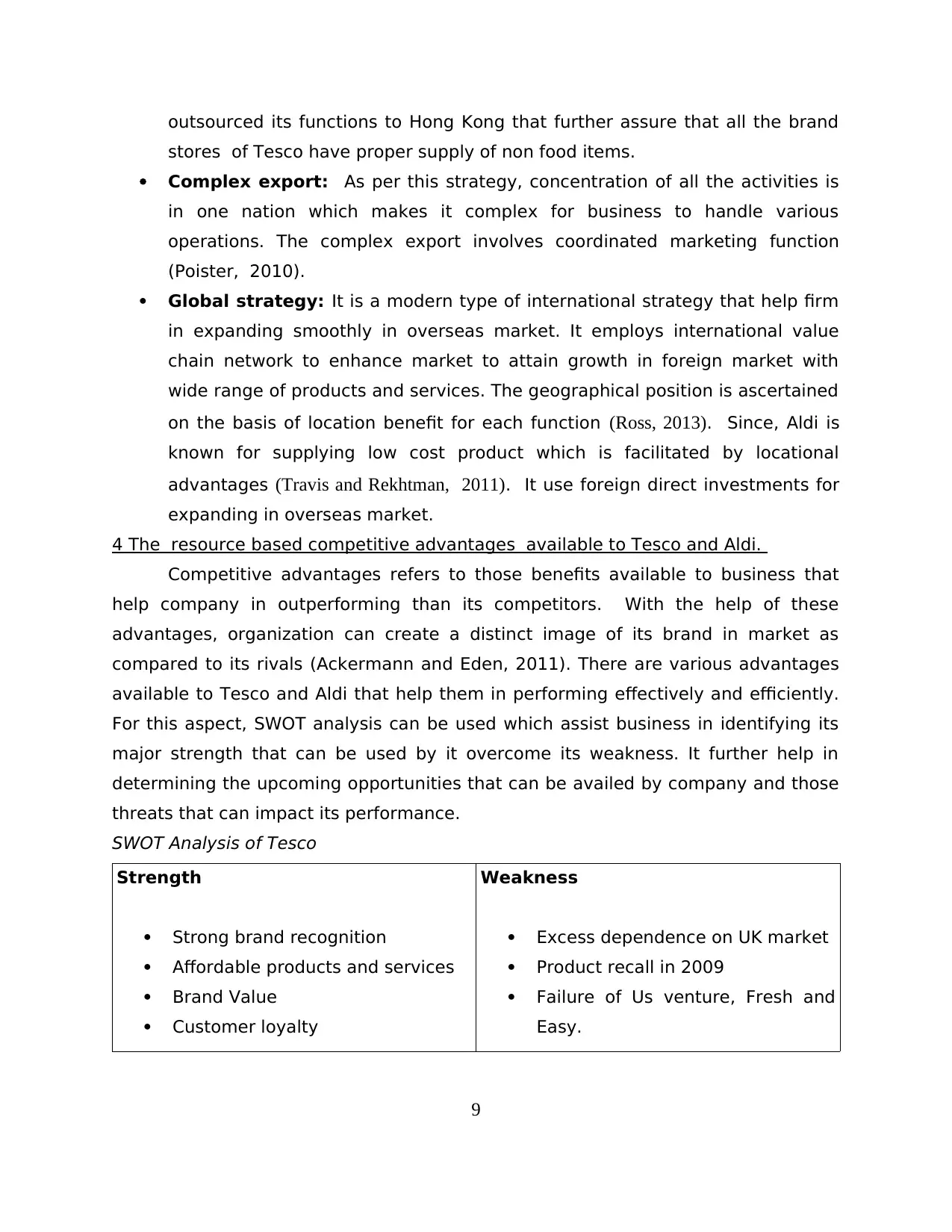
outsourced its functions to Hong Kong that further assure that all the brand
stores of Tesco have proper supply of non food items.
Complex export: As per this strategy, concentration of all the activities is
in one nation which makes it complex for business to handle various
operations. The complex export involves coordinated marketing function
(Poister, 2010).
Global strategy: It is a modern type of international strategy that help firm
in expanding smoothly in overseas market. It employs international value
chain network to enhance market to attain growth in foreign market with
wide range of products and services. The geographical position is ascertained
on the basis of location benefit for each function (Ross, 2013). Since, Aldi is
known for supplying low cost product which is facilitated by locational
advantages (Travis and Rekhtman, 2011). It use foreign direct investments for
expanding in overseas market.
4 The resource based competitive advantages available to Tesco and Aldi.
Competitive advantages refers to those benefits available to business that
help company in outperforming than its competitors. With the help of these
advantages, organization can create a distinct image of its brand in market as
compared to its rivals (Ackermann and Eden, 2011). There are various advantages
available to Tesco and Aldi that help them in performing effectively and efficiently.
For this aspect, SWOT analysis can be used which assist business in identifying its
major strength that can be used by it overcome its weakness. It further help in
determining the upcoming opportunities that can be availed by company and those
threats that can impact its performance.
SWOT Analysis of Tesco
Strength
Strong brand recognition
Affordable products and services
Brand Value
Customer loyalty
Weakness
Excess dependence on UK market
Product recall in 2009
Failure of Us venture, Fresh and
Easy.
9
stores of Tesco have proper supply of non food items.
Complex export: As per this strategy, concentration of all the activities is
in one nation which makes it complex for business to handle various
operations. The complex export involves coordinated marketing function
(Poister, 2010).
Global strategy: It is a modern type of international strategy that help firm
in expanding smoothly in overseas market. It employs international value
chain network to enhance market to attain growth in foreign market with
wide range of products and services. The geographical position is ascertained
on the basis of location benefit for each function (Ross, 2013). Since, Aldi is
known for supplying low cost product which is facilitated by locational
advantages (Travis and Rekhtman, 2011). It use foreign direct investments for
expanding in overseas market.
4 The resource based competitive advantages available to Tesco and Aldi.
Competitive advantages refers to those benefits available to business that
help company in outperforming than its competitors. With the help of these
advantages, organization can create a distinct image of its brand in market as
compared to its rivals (Ackermann and Eden, 2011). There are various advantages
available to Tesco and Aldi that help them in performing effectively and efficiently.
For this aspect, SWOT analysis can be used which assist business in identifying its
major strength that can be used by it overcome its weakness. It further help in
determining the upcoming opportunities that can be availed by company and those
threats that can impact its performance.
SWOT Analysis of Tesco
Strength
Strong brand recognition
Affordable products and services
Brand Value
Customer loyalty
Weakness
Excess dependence on UK market
Product recall in 2009
Failure of Us venture, Fresh and
Easy.
9
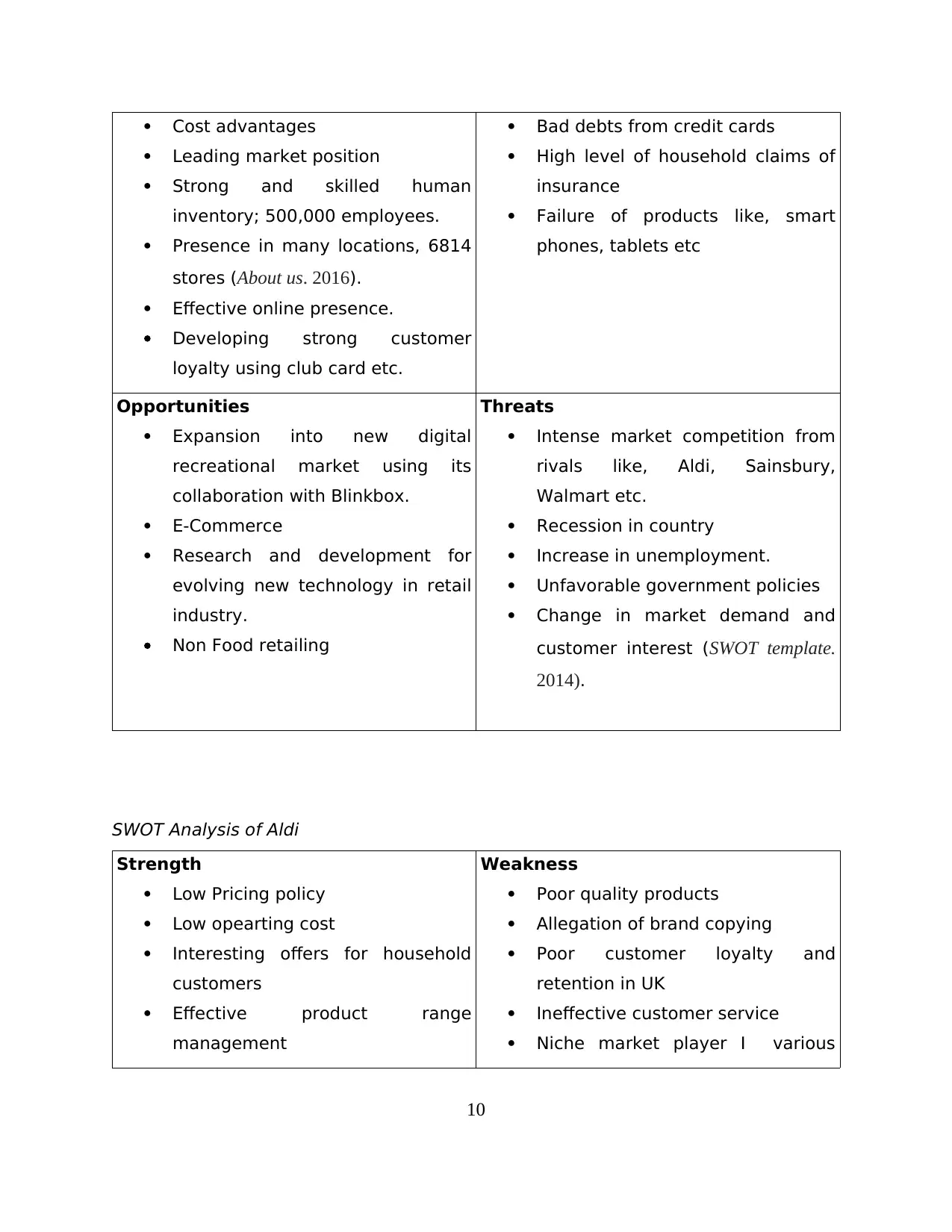
Cost advantages
Leading market position
Strong and skilled human
inventory; 500,000 employees.
Presence in many locations, 6814
stores (About us. 2016).
Effective online presence.
Developing strong customer
loyalty using club card etc.
Bad debts from credit cards
High level of household claims of
insurance
Failure of products like, smart
phones, tablets etc
Opportunities
Expansion into new digital
recreational market using its
collaboration with Blinkbox.
E-Commerce
Research and development for
evolving new technology in retail
industry.
Non Food retailing
Threats
Intense market competition from
rivals like, Aldi, Sainsbury,
Walmart etc.
Recession in country
Increase in unemployment.
Unfavorable government policies
Change in market demand and
customer interest (SWOT template.
2014).
SWOT Analysis of Aldi
Strength
Low Pricing policy
Low opearting cost
Interesting offers for household
customers
Effective product range
management
Weakness
Poor quality products
Allegation of brand copying
Poor customer loyalty and
retention in UK
Ineffective customer service
Niche market player I various
10
Leading market position
Strong and skilled human
inventory; 500,000 employees.
Presence in many locations, 6814
stores (About us. 2016).
Effective online presence.
Developing strong customer
loyalty using club card etc.
Bad debts from credit cards
High level of household claims of
insurance
Failure of products like, smart
phones, tablets etc
Opportunities
Expansion into new digital
recreational market using its
collaboration with Blinkbox.
E-Commerce
Research and development for
evolving new technology in retail
industry.
Non Food retailing
Threats
Intense market competition from
rivals like, Aldi, Sainsbury,
Walmart etc.
Recession in country
Increase in unemployment.
Unfavorable government policies
Change in market demand and
customer interest (SWOT template.
2014).
SWOT Analysis of Aldi
Strength
Low Pricing policy
Low opearting cost
Interesting offers for household
customers
Effective product range
management
Weakness
Poor quality products
Allegation of brand copying
Poor customer loyalty and
retention in UK
Ineffective customer service
Niche market player I various
10
Paraphrase This Document
Need a fresh take? Get an instant paraphrase of this document with our AI Paraphraser
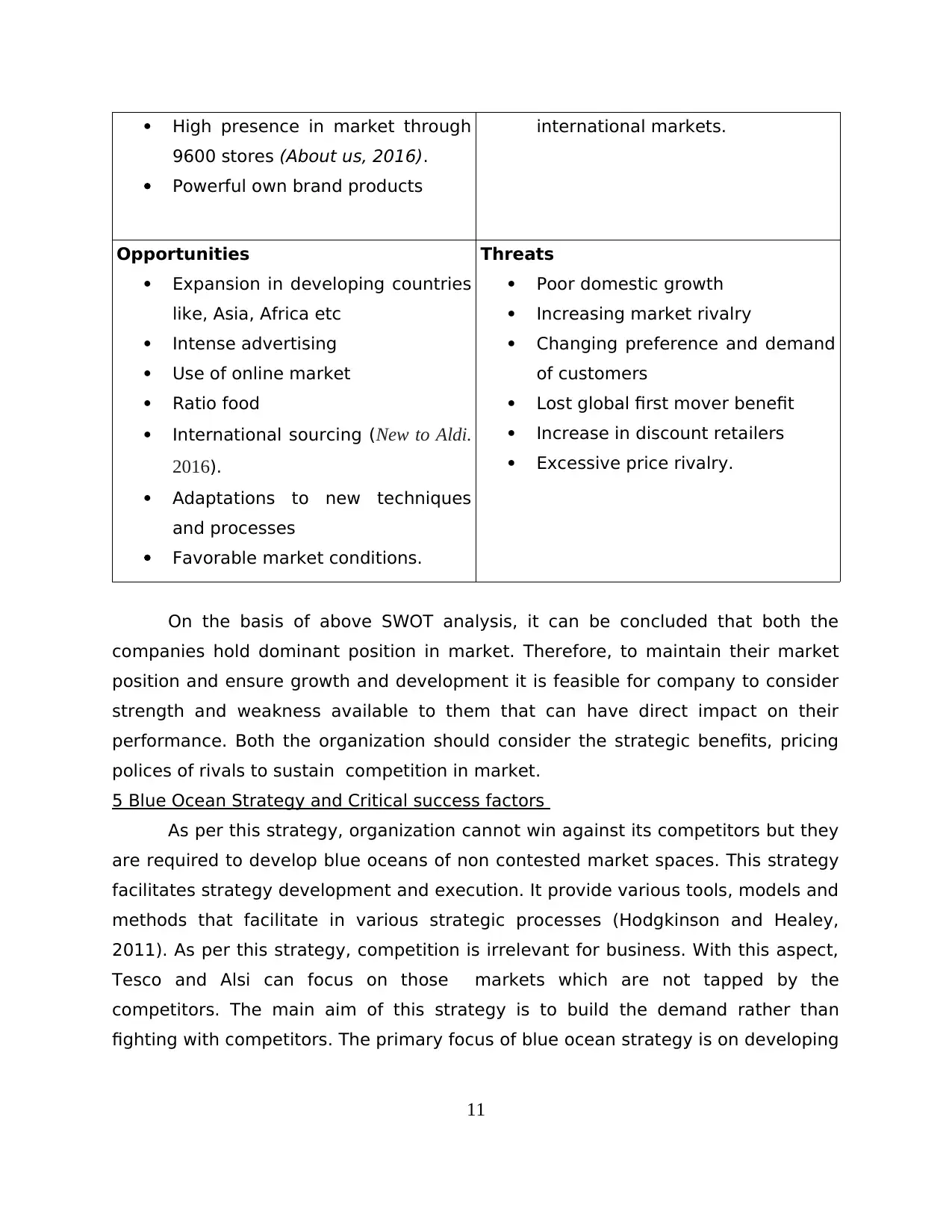
High presence in market through
9600 stores (About us, 2016).
Powerful own brand products
international markets.
Opportunities
Expansion in developing countries
like, Asia, Africa etc
Intense advertising
Use of online market
Ratio food
International sourcing (New to Aldi.
2016).
Adaptations to new techniques
and processes
Favorable market conditions.
Threats
Poor domestic growth
Increasing market rivalry
Changing preference and demand
of customers
Lost global first mover benefit
Increase in discount retailers
Excessive price rivalry.
On the basis of above SWOT analysis, it can be concluded that both the
companies hold dominant position in market. Therefore, to maintain their market
position and ensure growth and development it is feasible for company to consider
strength and weakness available to them that can have direct impact on their
performance. Both the organization should consider the strategic benefits, pricing
polices of rivals to sustain competition in market.
5 Blue Ocean Strategy and Critical success factors
As per this strategy, organization cannot win against its competitors but they
are required to develop blue oceans of non contested market spaces. This strategy
facilitates strategy development and execution. It provide various tools, models and
methods that facilitate in various strategic processes (Hodgkinson and Healey,
2011). As per this strategy, competition is irrelevant for business. With this aspect,
Tesco and Alsi can focus on those markets which are not tapped by the
competitors. The main aim of this strategy is to build the demand rather than
fighting with competitors. The primary focus of blue ocean strategy is on developing
11
9600 stores (About us, 2016).
Powerful own brand products
international markets.
Opportunities
Expansion in developing countries
like, Asia, Africa etc
Intense advertising
Use of online market
Ratio food
International sourcing (New to Aldi.
2016).
Adaptations to new techniques
and processes
Favorable market conditions.
Threats
Poor domestic growth
Increasing market rivalry
Changing preference and demand
of customers
Lost global first mover benefit
Increase in discount retailers
Excessive price rivalry.
On the basis of above SWOT analysis, it can be concluded that both the
companies hold dominant position in market. Therefore, to maintain their market
position and ensure growth and development it is feasible for company to consider
strength and weakness available to them that can have direct impact on their
performance. Both the organization should consider the strategic benefits, pricing
polices of rivals to sustain competition in market.
5 Blue Ocean Strategy and Critical success factors
As per this strategy, organization cannot win against its competitors but they
are required to develop blue oceans of non contested market spaces. This strategy
facilitates strategy development and execution. It provide various tools, models and
methods that facilitate in various strategic processes (Hodgkinson and Healey,
2011). As per this strategy, competition is irrelevant for business. With this aspect,
Tesco and Alsi can focus on those markets which are not tapped by the
competitors. The main aim of this strategy is to build the demand rather than
fighting with competitors. The primary focus of blue ocean strategy is on developing
11
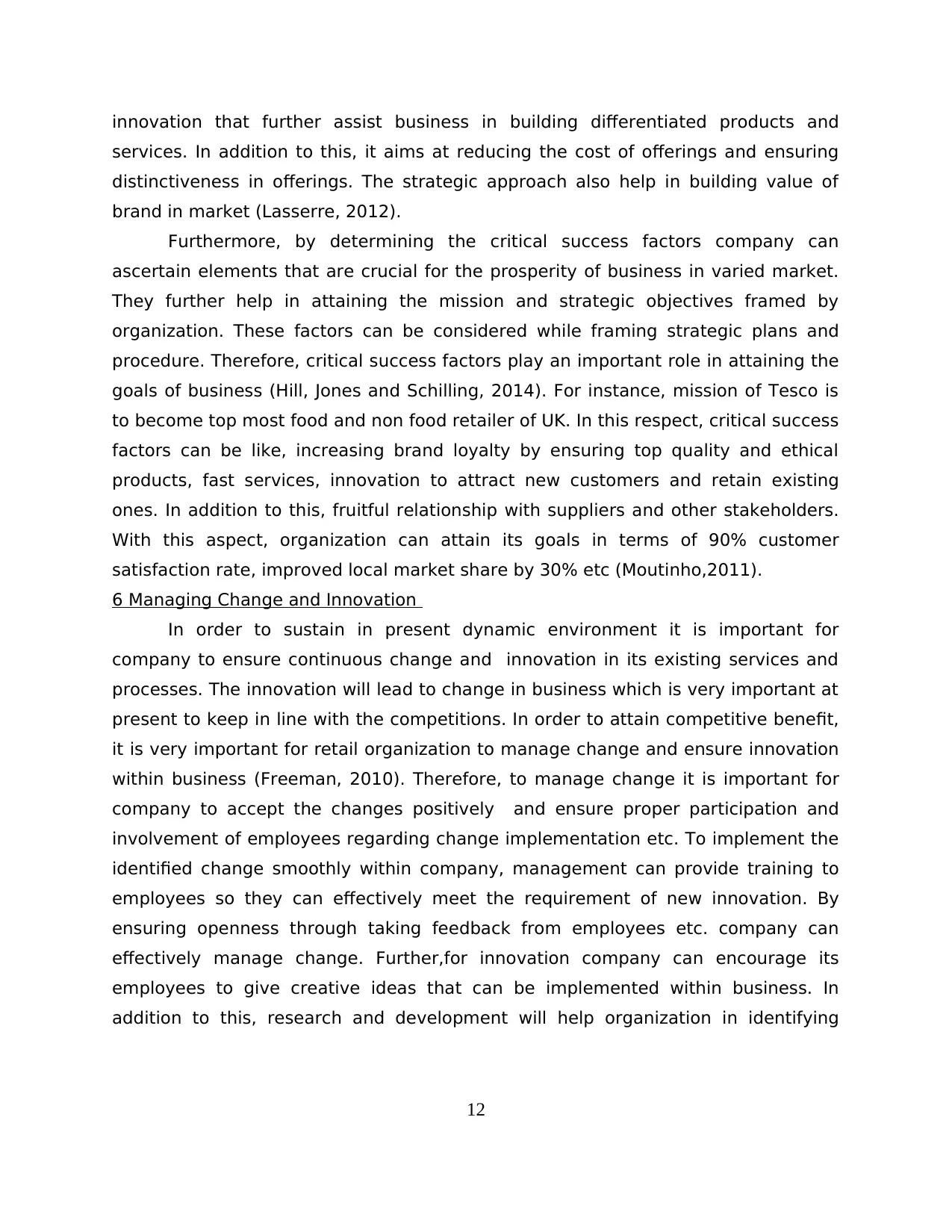
innovation that further assist business in building differentiated products and
services. In addition to this, it aims at reducing the cost of offerings and ensuring
distinctiveness in offerings. The strategic approach also help in building value of
brand in market (Lasserre, 2012).
Furthermore, by determining the critical success factors company can
ascertain elements that are crucial for the prosperity of business in varied market.
They further help in attaining the mission and strategic objectives framed by
organization. These factors can be considered while framing strategic plans and
procedure. Therefore, critical success factors play an important role in attaining the
goals of business (Hill, Jones and Schilling, 2014). For instance, mission of Tesco is
to become top most food and non food retailer of UK. In this respect, critical success
factors can be like, increasing brand loyalty by ensuring top quality and ethical
products, fast services, innovation to attract new customers and retain existing
ones. In addition to this, fruitful relationship with suppliers and other stakeholders.
With this aspect, organization can attain its goals in terms of 90% customer
satisfaction rate, improved local market share by 30% etc (Moutinho,2011).
6 Managing Change and Innovation
In order to sustain in present dynamic environment it is important for
company to ensure continuous change and innovation in its existing services and
processes. The innovation will lead to change in business which is very important at
present to keep in line with the competitions. In order to attain competitive benefit,
it is very important for retail organization to manage change and ensure innovation
within business (Freeman, 2010). Therefore, to manage change it is important for
company to accept the changes positively and ensure proper participation and
involvement of employees regarding change implementation etc. To implement the
identified change smoothly within company, management can provide training to
employees so they can effectively meet the requirement of new innovation. By
ensuring openness through taking feedback from employees etc. company can
effectively manage change. Further,for innovation company can encourage its
employees to give creative ideas that can be implemented within business. In
addition to this, research and development will help organization in identifying
12
services. In addition to this, it aims at reducing the cost of offerings and ensuring
distinctiveness in offerings. The strategic approach also help in building value of
brand in market (Lasserre, 2012).
Furthermore, by determining the critical success factors company can
ascertain elements that are crucial for the prosperity of business in varied market.
They further help in attaining the mission and strategic objectives framed by
organization. These factors can be considered while framing strategic plans and
procedure. Therefore, critical success factors play an important role in attaining the
goals of business (Hill, Jones and Schilling, 2014). For instance, mission of Tesco is
to become top most food and non food retailer of UK. In this respect, critical success
factors can be like, increasing brand loyalty by ensuring top quality and ethical
products, fast services, innovation to attract new customers and retain existing
ones. In addition to this, fruitful relationship with suppliers and other stakeholders.
With this aspect, organization can attain its goals in terms of 90% customer
satisfaction rate, improved local market share by 30% etc (Moutinho,2011).
6 Managing Change and Innovation
In order to sustain in present dynamic environment it is important for
company to ensure continuous change and innovation in its existing services and
processes. The innovation will lead to change in business which is very important at
present to keep in line with the competitions. In order to attain competitive benefit,
it is very important for retail organization to manage change and ensure innovation
within business (Freeman, 2010). Therefore, to manage change it is important for
company to accept the changes positively and ensure proper participation and
involvement of employees regarding change implementation etc. To implement the
identified change smoothly within company, management can provide training to
employees so they can effectively meet the requirement of new innovation. By
ensuring openness through taking feedback from employees etc. company can
effectively manage change. Further,for innovation company can encourage its
employees to give creative ideas that can be implemented within business. In
addition to this, research and development will help organization in identifying
12
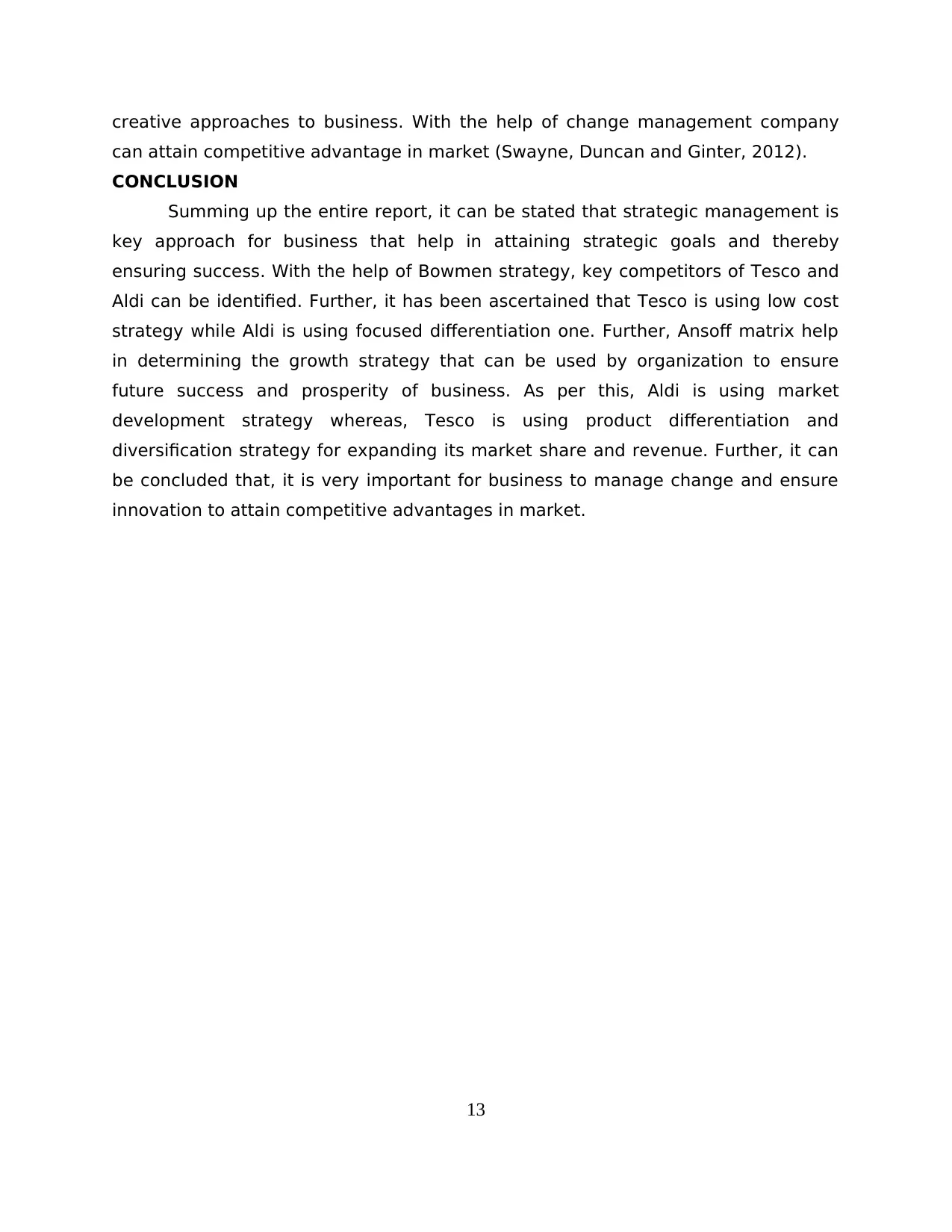
creative approaches to business. With the help of change management company
can attain competitive advantage in market (Swayne, Duncan and Ginter, 2012).
CONCLUSION
Summing up the entire report, it can be stated that strategic management is
key approach for business that help in attaining strategic goals and thereby
ensuring success. With the help of Bowmen strategy, key competitors of Tesco and
Aldi can be identified. Further, it has been ascertained that Tesco is using low cost
strategy while Aldi is using focused differentiation one. Further, Ansoff matrix help
in determining the growth strategy that can be used by organization to ensure
future success and prosperity of business. As per this, Aldi is using market
development strategy whereas, Tesco is using product differentiation and
diversification strategy for expanding its market share and revenue. Further, it can
be concluded that, it is very important for business to manage change and ensure
innovation to attain competitive advantages in market.
13
can attain competitive advantage in market (Swayne, Duncan and Ginter, 2012).
CONCLUSION
Summing up the entire report, it can be stated that strategic management is
key approach for business that help in attaining strategic goals and thereby
ensuring success. With the help of Bowmen strategy, key competitors of Tesco and
Aldi can be identified. Further, it has been ascertained that Tesco is using low cost
strategy while Aldi is using focused differentiation one. Further, Ansoff matrix help
in determining the growth strategy that can be used by organization to ensure
future success and prosperity of business. As per this, Aldi is using market
development strategy whereas, Tesco is using product differentiation and
diversification strategy for expanding its market share and revenue. Further, it can
be concluded that, it is very important for business to manage change and ensure
innovation to attain competitive advantages in market.
13
Secure Best Marks with AI Grader
Need help grading? Try our AI Grader for instant feedback on your assignments.
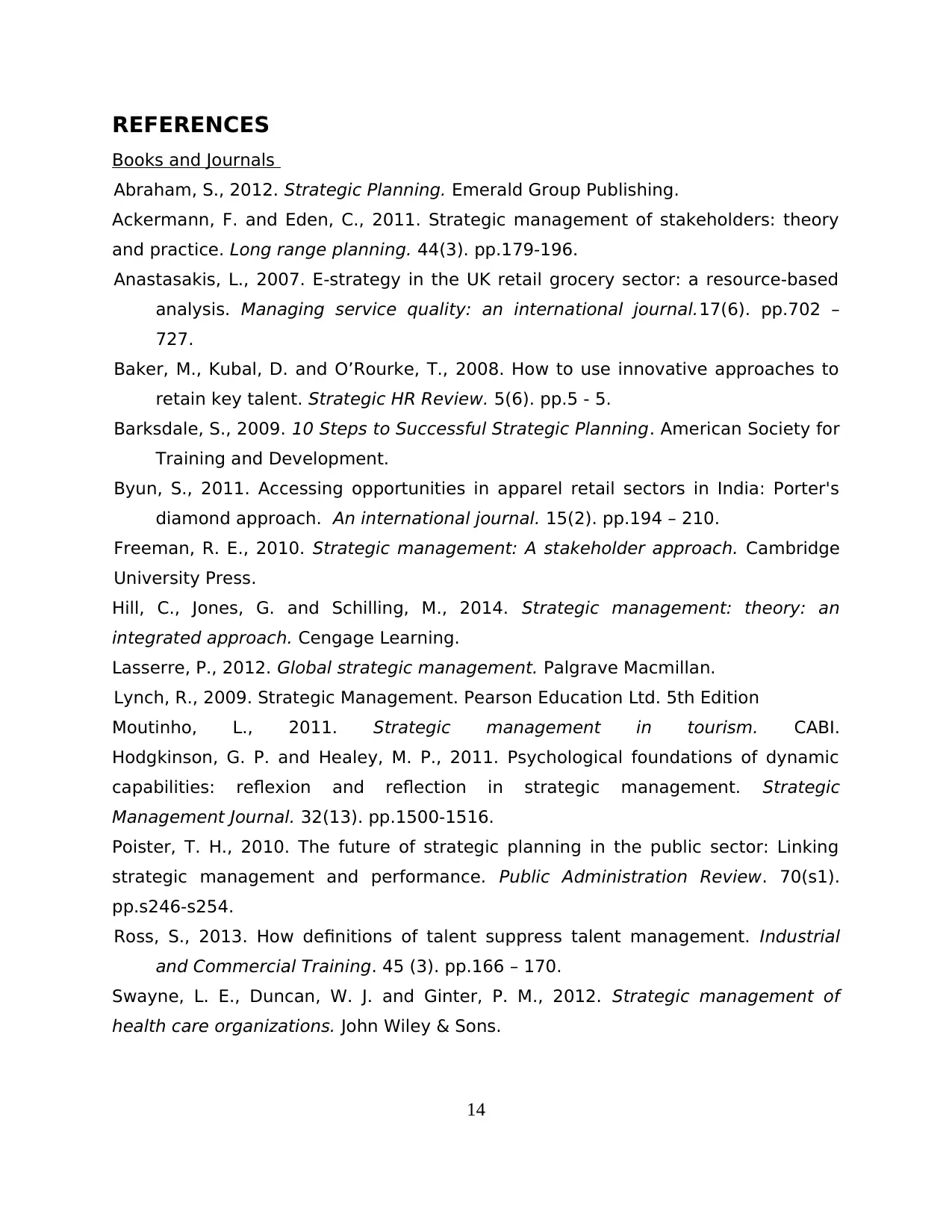
REFERENCES
Books and Journals
Abraham, S., 2012. Strategic Planning. Emerald Group Publishing.
Ackermann, F. and Eden, C., 2011. Strategic management of stakeholders: theory
and practice. Long range planning. 44(3). pp.179-196.
Anastasakis, L., 2007. E‐strategy in the UK retail grocery sector: a resource‐based
analysis. Managing service quality: an international journal.17(6). pp.702 –
727.
Baker, M., Kubal, D. and O’Rourke, T., 2008. How to use innovative approaches to
retain key talent. Strategic HR Review. 5(6). pp.5 - 5.
Barksdale, S., 2009. 10 Steps to Successful Strategic Planning. American Society for
Training and Development.
Byun, S., 2011. Accessing opportunities in apparel retail sectors in India: Porter's
diamond approach. An international journal. 15(2). pp.194 – 210.
Freeman, R. E., 2010. Strategic management: A stakeholder approach. Cambridge
University Press.
Hill, C., Jones, G. and Schilling, M., 2014. Strategic management: theory: an
integrated approach. Cengage Learning.
Lasserre, P., 2012. Global strategic management. Palgrave Macmillan.
Lynch, R., 2009. Strategic Management. Pearson Education Ltd. 5th Edition
Moutinho, L., 2011. Strategic management in tourism. CABI.
Hodgkinson, G. P. and Healey, M. P., 2011. Psychological foundations of dynamic
capabilities: reflexion and reflection in strategic management. Strategic
Management Journal. 32(13). pp.1500-1516.
Poister, T. H., 2010. The future of strategic planning in the public sector: Linking
strategic management and performance. Public Administration Review. 70(s1).
pp.s246-s254.
Ross, S., 2013. How definitions of talent suppress talent management. Industrial
and Commercial Training. 45 (3). pp.166 – 170.
Swayne, L. E., Duncan, W. J. and Ginter, P. M., 2012. Strategic management of
health care organizations. John Wiley & Sons.
14
Books and Journals
Abraham, S., 2012. Strategic Planning. Emerald Group Publishing.
Ackermann, F. and Eden, C., 2011. Strategic management of stakeholders: theory
and practice. Long range planning. 44(3). pp.179-196.
Anastasakis, L., 2007. E‐strategy in the UK retail grocery sector: a resource‐based
analysis. Managing service quality: an international journal.17(6). pp.702 –
727.
Baker, M., Kubal, D. and O’Rourke, T., 2008. How to use innovative approaches to
retain key talent. Strategic HR Review. 5(6). pp.5 - 5.
Barksdale, S., 2009. 10 Steps to Successful Strategic Planning. American Society for
Training and Development.
Byun, S., 2011. Accessing opportunities in apparel retail sectors in India: Porter's
diamond approach. An international journal. 15(2). pp.194 – 210.
Freeman, R. E., 2010. Strategic management: A stakeholder approach. Cambridge
University Press.
Hill, C., Jones, G. and Schilling, M., 2014. Strategic management: theory: an
integrated approach. Cengage Learning.
Lasserre, P., 2012. Global strategic management. Palgrave Macmillan.
Lynch, R., 2009. Strategic Management. Pearson Education Ltd. 5th Edition
Moutinho, L., 2011. Strategic management in tourism. CABI.
Hodgkinson, G. P. and Healey, M. P., 2011. Psychological foundations of dynamic
capabilities: reflexion and reflection in strategic management. Strategic
Management Journal. 32(13). pp.1500-1516.
Poister, T. H., 2010. The future of strategic planning in the public sector: Linking
strategic management and performance. Public Administration Review. 70(s1).
pp.s246-s254.
Ross, S., 2013. How definitions of talent suppress talent management. Industrial
and Commercial Training. 45 (3). pp.166 – 170.
Swayne, L. E., Duncan, W. J. and Ginter, P. M., 2012. Strategic management of
health care organizations. John Wiley & Sons.
14
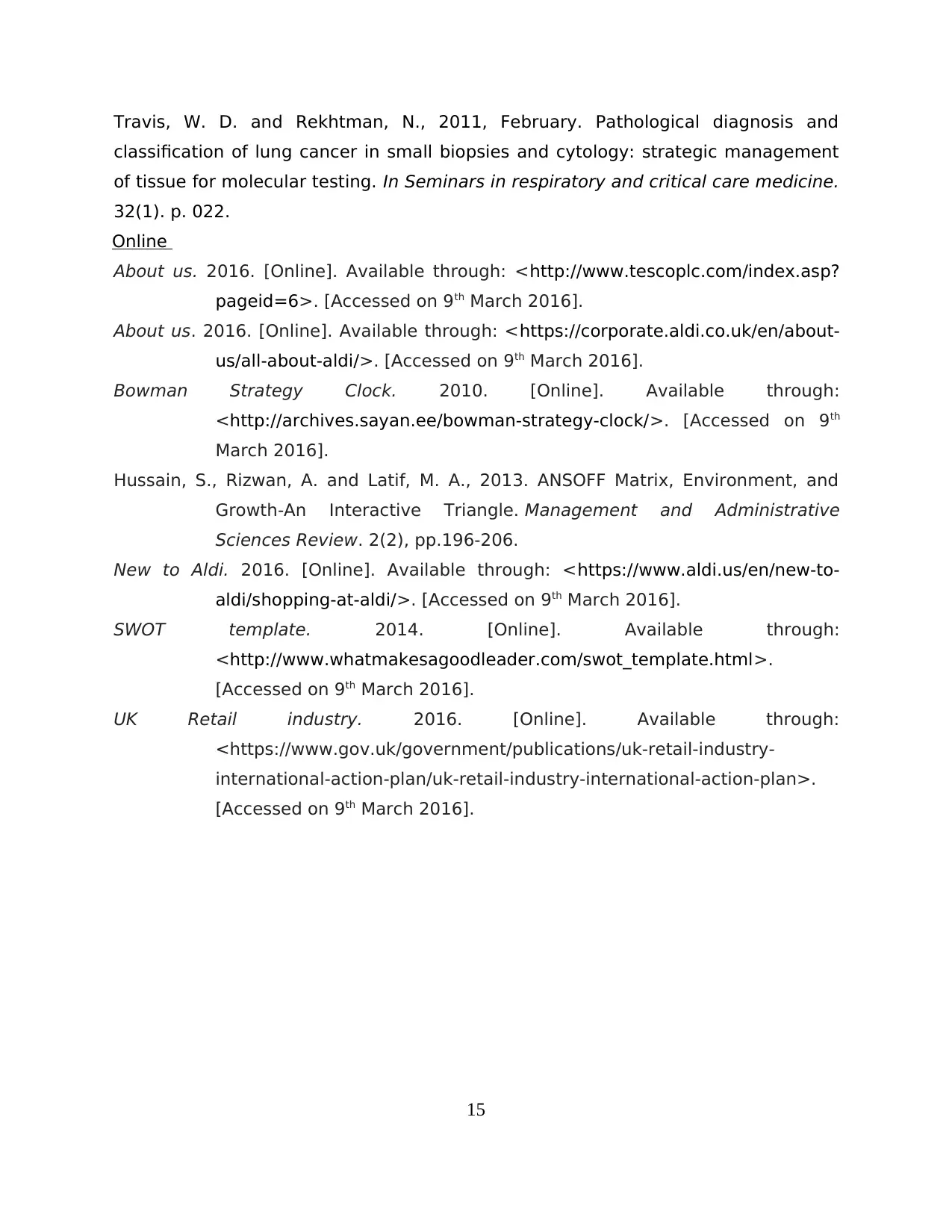
Travis, W. D. and Rekhtman, N., 2011, February. Pathological diagnosis and
classification of lung cancer in small biopsies and cytology: strategic management
of tissue for molecular testing. In Seminars in respiratory and critical care medicine.
32(1). p. 022.
Online
About us. 2016. [Online]. Available through: <http://www.tescoplc.com/index.asp?
pageid=6>. [Accessed on 9th March 2016].
About us. 2016. [Online]. Available through: <https://corporate.aldi.co.uk/en/about-
us/all-about-aldi/>. [Accessed on 9th March 2016].
Bowman Strategy Clock. 2010. [Online]. Available through:
<http://archives.sayan.ee/bowman-strategy-clock/>. [Accessed on 9th
March 2016].
Hussain, S., Rizwan, A. and Latif, M. A., 2013. ANSOFF Matrix, Environment, and
Growth-An Interactive Triangle. Management and Administrative
Sciences Review. 2(2), pp.196-206.
New to Aldi. 2016. [Online]. Available through: <https://www.aldi.us/en/new-to-
aldi/shopping-at-aldi/>. [Accessed on 9th March 2016].
SWOT template. 2014. [Online]. Available through:
<http://www.whatmakesagoodleader.com/swot_template.html>.
[Accessed on 9th March 2016].
UK Retail industry. 2016. [Online]. Available through:
<https://www.gov.uk/government/publications/uk-retail-industry-
international-action-plan/uk-retail-industry-international-action-plan>.
[Accessed on 9th March 2016].
15
classification of lung cancer in small biopsies and cytology: strategic management
of tissue for molecular testing. In Seminars in respiratory and critical care medicine.
32(1). p. 022.
Online
About us. 2016. [Online]. Available through: <http://www.tescoplc.com/index.asp?
pageid=6>. [Accessed on 9th March 2016].
About us. 2016. [Online]. Available through: <https://corporate.aldi.co.uk/en/about-
us/all-about-aldi/>. [Accessed on 9th March 2016].
Bowman Strategy Clock. 2010. [Online]. Available through:
<http://archives.sayan.ee/bowman-strategy-clock/>. [Accessed on 9th
March 2016].
Hussain, S., Rizwan, A. and Latif, M. A., 2013. ANSOFF Matrix, Environment, and
Growth-An Interactive Triangle. Management and Administrative
Sciences Review. 2(2), pp.196-206.
New to Aldi. 2016. [Online]. Available through: <https://www.aldi.us/en/new-to-
aldi/shopping-at-aldi/>. [Accessed on 9th March 2016].
SWOT template. 2014. [Online]. Available through:
<http://www.whatmakesagoodleader.com/swot_template.html>.
[Accessed on 9th March 2016].
UK Retail industry. 2016. [Online]. Available through:
<https://www.gov.uk/government/publications/uk-retail-industry-
international-action-plan/uk-retail-industry-international-action-plan>.
[Accessed on 9th March 2016].
15

16
1 out of 16
Related Documents
Your All-in-One AI-Powered Toolkit for Academic Success.
+13062052269
info@desklib.com
Available 24*7 on WhatsApp / Email
![[object Object]](/_next/static/media/star-bottom.7253800d.svg)
Unlock your academic potential
© 2024 | Zucol Services PVT LTD | All rights reserved.





